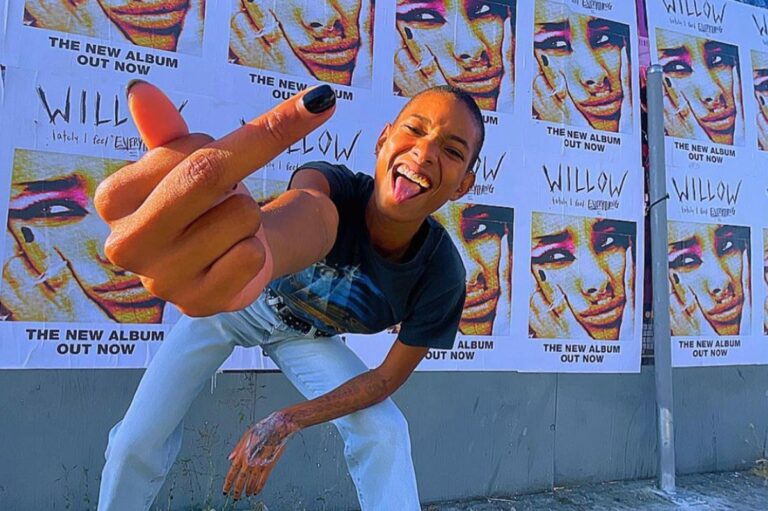Why is pop punk making a comeback in 2021?
Pop punk has infiltrated the mainstream, creating the sonic backbone for some of this year’s most listened to albums. From Olivia Rodrigo’s SOUR to Pinkshift’s song ‘i’m gonna tell my therapist on you’, the sounds of the 90s and early 00s have been making a definite comeback. Even one of the Kardashians is dating Travis Barker, drummer for the band Blink-182, propelling the genre’s heavily tattooed and grunge-inspired aesthetics into the mainstream in a big way. However, gen Z has adapted the trend to their own style and perspectives, ultimately creating a more diverse and inclusive atmosphere around the genre.
The most telling example of gen Z’s reiteration of 2000s punk can be seen in egirl and eboy aesthetics. This subculture was popularised in the internet of the early 2010s—think the height of Tumblr—and made prominent again by TikTok users. Closet staples of the community include thick chains, monochrome stripes, and heavy eyeliner paired with softer anime-inspired qualities.
In July 2019, Kish Lal wrote for Dazed that the aesthetics of this punk subculture are “the antidote to the homogenised IG aesthetic” as reinforced by cookie-cutter influencers. Embracing the internet-saturated world they grew up in, gen Zers have been using the skills they’ve learned from online makeup tutorials to create alternative, rainbow-hued looks as opposed to full-contour glam. Taking the rise of this punk-inspired subculture into account, it seems inevitable that those engaging with the aesthetics would champion a sound that matches their outlooks.
Though the pop punk sound has flourished in 2021, the revival has been a few years in the making. The first musical inklings of its re-emergence can be traced in trends in the heavily autotuned, melancholic rap and hip hop of the internet in recent years; think Lil Uzi Vert and Juice WRLD. Rolling Stone writer Stephen Witt cited the decline of the emo rap genre as taking place in early 2019 after the death of Lil Peep, Tekashi 6ix9ine’s legal battles, and a slew of other events, both tragic and notorious, took place.
While contemporary pop punk has many roots in the sounds of Soundcloud rap popularised in the late 2010s, the genre is significantly more diverse. In contrast to the cis-male dominance of its predecessors, headlining acts of the present genre include Olivia Rodrigo, Meet Me @ The Altar, and Pinkshift. Even Willow Smith, who previously specialised in soulful, alternative R&B tracks, has veered into pop punk territory.
On her most recent album lately I feel EVERYTHING, released 16 July 2021, Smith works with pop punk icons—and childhood heroes of hers—Travis Barker and Avril Lavigne. Coming a long way from ‘Whip My Hair’, the singer infused the sounds of her youth into tracks like ‘transparent soul’, ‘XTRA’, and ‘¡BREAKOUT!’ while incorporating her own specific emotional experience as a black female into them. This perspective she shares wasn’t in the mainstream in the early 2000s, as Fall Out Boy and Green Day took centre stage.
It’s incredibly noteworthy that this time around—in the aftermath of the Me Too movement and rise in awareness of intersectional marginalisation—the once-male-dominated pop punk genre is now being frontlined by women, gen Z women in particular. When interviewed by The Independent in April 2021, 20-year-old guitarist for Meet Me @ The Altar, Téa Campbell, said, “It’s so incredibly important to have representation as POC women in this scene […] The scene belongs to everyone and it’s time that the stages reflect that.”
While feminist and LGBTQIA+ voices gained popularity in the 80s and 90s through queercore and riot grrrl movements, they were outshined by the male-dominated alternative genre. Today, as the space has gradually widened and continues to do so, these voices have confidently resurfaced. The prominence of egirl and eboy cultural attitudes could also have a role in this increased inclusivity. In Dazed, one self-proclaimed eboy and influencer named Jamison offers that the eboy subculture “allows for more freedom of expression and the chance to experiment with traditionally feminine looks that men—especially straight men—have been taught to shy away from.”
Another component to the genre’s renewed popularity could be due to gen Z’s deep awareness of systemic flaws, as echoed in Willow Smith’s interview with The Evening Standard from September 2021. In the piece, the singer is quoted saying that her generation “has an insatiable desire to right the wrongs of the world […] We’re tired of all the decisions that have been made before us.” She finishes this statement off by saying, “We’re raising awareness of the issues that affect us all, we’re taking control.” Taking this into consideration, the re-emergence of pop punk seems even more inevitable. When collective emotions seem to be at an all-time high due to the very social media platforms that give so many young people a voice, it seems inevitable that this emotion-laden genre and its signature abrasive vocals have come back into the spotlight. Similar to other bands engaging with the sound, Willow recognises the power she has in drawing attention to the experiences of her generation and is using her voice, in a pop-punk cadence, to do so.
The pop punk genre and the specific internet culture that comes with it can be viewed all-in-all as a rejection of the dominant attitudes often expressed by older generations on the internet. By using the digital skill sets they’ve developed throughout childhood and the music genres of their youth, gen Zers are able to express their own concerns with the world they’ve come of age in.





